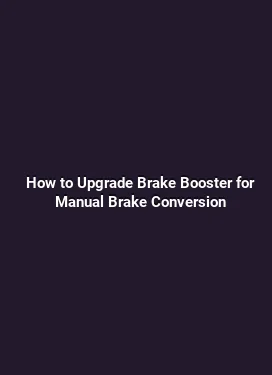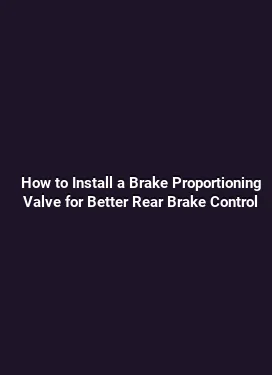How to Choose the Right Brake Pad Compound for Your Driving Style
Understanding the Role of Brake Pad Compounds in Braking Performance

Brake pads are a critical link in the braking system, translating hydraulic force into the friction needed to slow and stop the vehicle. The compound composition of a pad determines how it responds to heat, pressure, and different driving demands. From street cars that spend most of their time in urban traffic to sportier setups that demand rapid deceleration, the right pad material can influence bite, fade resistance, dust production, and overall feel. The optimal choice balances stopping power with wear characteristics, rotor compatibility, and driver expectations across varying temperatures and road surfaces.
As driving styles vary—from smooth, steady stopping to aggressive, high-speed braking—the pad’s friction characteristics come into play. A pad designed for quick, repeated stops in city traffic will behave differently than a pad engineered for track days, where heat buildup and sustained high-speed deceleration are the norms. The selection process therefore hinges on understanding how pad chemistry interacts with operating conditions, rotor materials, and the vehicle’s weight and braking system design.
First Principles: How Driving Style Shapes Pad Selection
Driving style sets the loading pattern on the braking system. Occasional hard braking on uphill mountain roads places a premium on fade resistance and a stable friction feel as heat builds. Busy urban commutes emphasize low noise, low dust, and predictable performance at moderate temperatures. A driver who frequently tows heavy loads or drives in hot climates may require compounds with higher thermal capacity to prevent brake fade and maintain consistent performance. In contrast, a performance-oriented driver may prioritize aggressive initial bite and consistent feel at high temperatures, accepting more rotor wear or slightly higher dust as trade-offs.
Understanding your typical braking profile helps narrow compound options before delving into specifics. Key questions include: Do you spend long stretches on highways with repeated deceleration, or do you navigate stop-and-go traffic with frequent quick stops? Do you haul payloads that shift weight distribution, or do you frequently drive in hot or humid climates? Each scenario benefits from a tailored approach to pad material selection, rotor compatibility, and bedding procedures that optimize friction stability over the pad’s service life.
Material Science Behind Brake Pad Compounds
Brake pad formulations are broadly categorized into semi-metallic, ceramic, and organic (non-asbestos organic, or NAO) compounds, each with distinct friction behavior, wear characteristics, and rotor interaction. Semi-metallic pads typically blend metallic fibers with fillers to achieve high thermal capacity and strong friction at elevated temperatures. They often deliver robust bite and fade resistance, though they may generate more rotor wear, dust, and noise in certain setups. Ceramic pads typically offer smooth, quiet operation, low dust, and stable friction across a wide temperature range, but they can be pricier and may not always deliver the same initial bite as high-metal-content compounds under certain conditions. Organic pads focus on quiet operation and rotor friendliness, providing gentle friction characteristics that suit everyday driving but may experience faster wear and reduced high-temperature performance in demanding driving scenarios.
Friction material chemistry also includes various blends and additives that influence initial bite, peak friction, and recovery. For example, compounds designed to maintain friction at low temperatures deliver more consistent performance in cold starts, while high-temperature formulations strive to minimize fade when repeated heavy braking is required. The interaction with rotor materials (cast iron, composite rotors, or drilled/slotted designs) and with caliper piston size further shapes the real-world performance you’ll experience. It’s not only about the base composition; the manufacturing process, bedding protocol, and even brake fluid compatibility contribute to the final braking feel.
How to Align Pad Choice with Vehicle and Usage
The vehicle’s weight, chassis balance, and braking system layout strongly influence pad selection. Heavy vehicles or those with large front-to-rear weight transfer typically demand pads with higher thermal capacity and strength to maintain consistent friction under load. Vehicles with performance-oriented suspensions may benefit from compounds that deliver a sharper initial bite and predictable fade, while mainstream vehicles used for daily commuting often prioritize low noise, low dust, and long pad life.
Rotor design and condition matter as well. Slotted and drilled rotors can alter heat dissipation and pad contact patterns, sometimes allowing for slightly different friction behavior. If rotors are worn or glazed, even a well-chosen pad can feel inconsistent. Therefore, assessing rotor condition alongside pad choice is essential. The goal is to pair a pad that harmonizes with rotor surface texture, metallurgy, and the caliper’s clamping force for balanced bite, modulation, and release.
Practical Guidelines for Everyday Driving to Performance Scenarios
For everyday driving at moderate speeds and temperatures, a low-dust, quiet, and reliable pad with decent wear life is often ideal. If you frequently drive in a hilly area or encounter frequent heavy deceleration, consider a pad that maintains friction at higher temperatures and resists fade. For weekend enthusiasts who push their vehicle on twisty roads or track days, a high-performance compound with strong high-temperature friction retention can provide superior control, albeit with increased rotor wear and potential noise in some installations.
When selecting pads, examine manufacturer specifications for a given compound’s operating temperature range, friction coefficient window, and recommended rotor types. Personal preferences—such as pedal feel, willingness to accept rotor wear, and tolerance for dust—also play a significant role. A thorough bedding-in ritual is essential to condition the pad surface to the rotor, ensuring stable friction characteristics from the first real-world braking cycles after installation.
Factors Influencing Bedding-In and Friction Stability

Bedding-in creates a gradual transfer layer of pad material onto the rotor, which helps establish consistent friction and prevents glazing. Typical bedding protocols involve a series of moderate to strong braking events with progressive heat buildup to avoid sudden thermal shocks. The exact procedure varies by pad and vehicle, so consulting the pad manufacturer guidance is advisable. A well-executed bedding process reduces the risk of initial noise, vibration, or uneven wear and contributes to longer pad and rotor life by establishing a uniform contact surface.
Maintenance, Longevity, and Real-World Performance
Maintenance routines influence how long a pad performs at its intended level. Regular inspection of brake pads for lining thickness, uneven wear, and rotor scoring helps identify mismatches between pad material and driving style early. If you notice increased pedal travel, reduced bite, or unusual noise, reassessing pad choice or rotor condition is a prudent step. In high-temperature environments or during heavy use, pads may experience faster wear or fading, signaling a potential need to upgrade to a compound with greater thermal tolerance.
Dust formation varies with pad composition. Ceramic and certain semi-metallic blends tend to produce less visible dust on wheels compared with some traditional semi-metallic compounds. For drivers seeking a cleaner appearance and quieter operation, low-dust options can be an appealing factor. Vehicle owners should weigh this preference against other performance attributes to arrive at a balanced decision.
Performance-Oriented Scenarios: Matching Pads to Track and Sport Driving
Track environments demand friction stability across repeated hard braking and high heat accumulation. In such cases, high-temperature capable compounds with consistent friction profiles under sustained load are favored. Pad wear becomes a secondary concern if the vehicle is purpose-built for performance and rotor maintenance is planned accordingly. It’s important to choose a pad that preserves control during corner entry and braking hard into the apex, while also maintaining predictable release to support smooth transitions through braking zones.
Even in performance contexts, rotor selection, caliper sizing, and brake cooling routes must align with pad physics. A coordinated approach—ensuring the pad compound, rotor geometry, and caliper clamping force work together—delivers the expected braking performance without surprising changes in feel as temperatures rise.
Installation, Compatibility, and Safety Considerations
Before installation, verify compatibility with the vehicle’s braking system and rotor design. Some pads require specific resistance to heat or can be sensitive to rotor texture and surface finish. Using pads that are not compatible with the rotor or caliper configuration can lead to suboptimal braking, noise, or accelerated wear. After installation, avoid harsh braking for the initial miles to allow the mating surface to stabilize. Regular checks on pad thickness and rotor surface help ensure a safe and stable braking experience over time.
Final Thoughts on a Thoughtful Choice
Choosing the right brake pad compound is not a one-size-fits-all decision. It requires aligning material properties with driving style, vehicle dynamics, rotor design, and anticipated operating temperatures. By understanding the balance between bite, fade resistance, wear, and noise, drivers can select a compound that delivers the confidence and control they expect from their braking system. The bedding-in process, ongoing maintenance, and appropriate rotor care complete the ecosystem that sustains predictable, safe, and enjoyable braking performance across a wide range of real-world scenarios.






